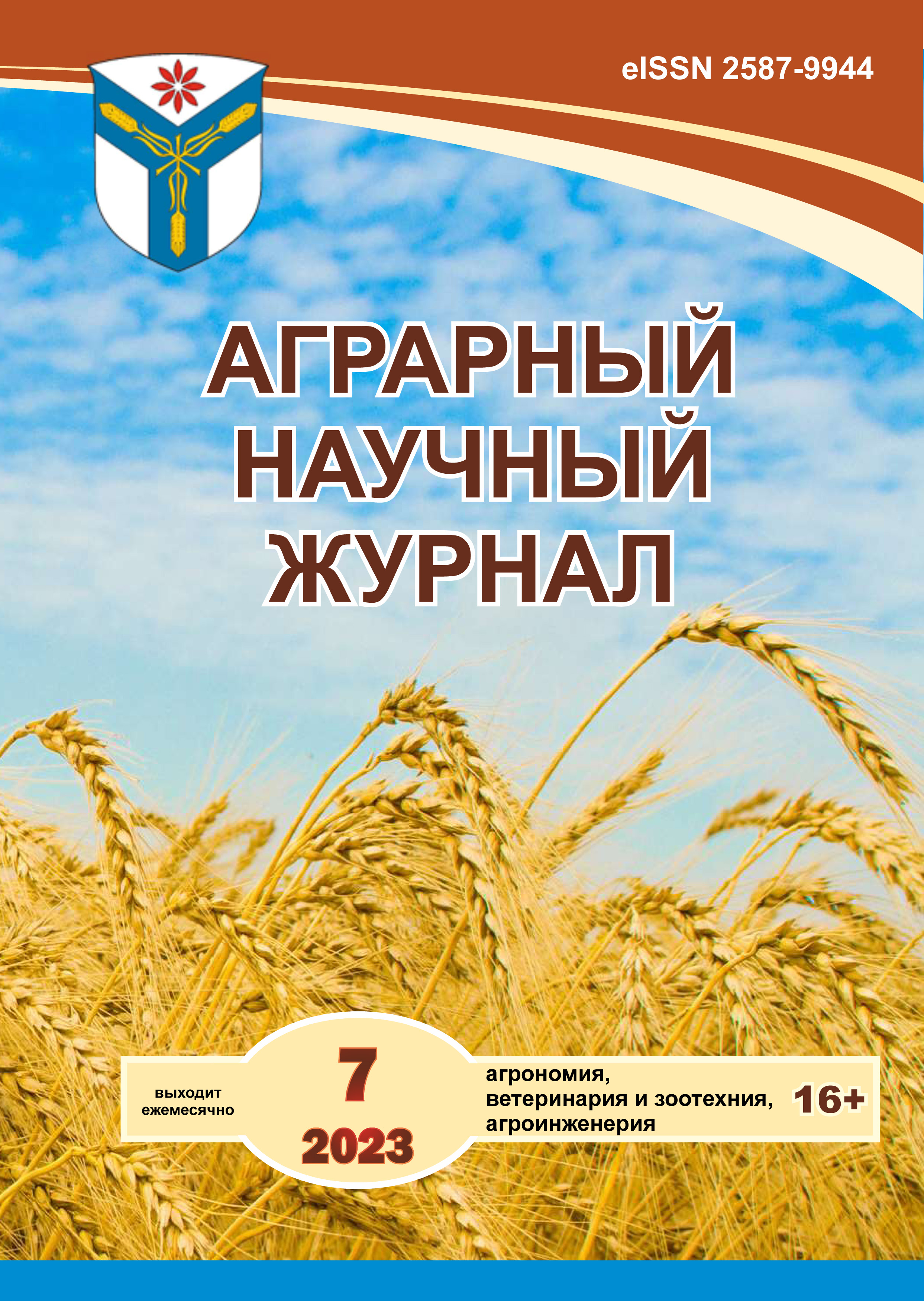Diseases and productivity of peas for grain sowing in the conditions of the Tyumen region
DOI:
https://doi.org/10.28983/asj.y2023i7pp39-47Keywords:
seed peas, morphotypes, varieties, diseases, protection techniques, efficiency, yieldAbstract
. Studies on the stability of resistance to leaf stock, crop productivity, the boundaries of different morphotypes of grain-oriented peas and the assessment of protection methods were carried out in the conditions of the northern forest-steppe of the Tyumen region. During the growing season, according to the indicators of peas, leaf-stem diseases are observed with different rates of development and timing of manifestation (Ascochyta, p. Uromyces, p. Erysiphe communis G). The development of diseases in allergic years is long: ascochitosis (p. Ascochyta) - 10-20%, powdery rose (p. Erysiphe communis) - 11-49%, rust (p. Uromyces) - 0.2-20%. The smallest damage of 5.5-6.6% was observed on the lines TM 12-158, 12-160, 12-162, 06-452, 12-214, 09-280 or 11% of the entire set of varieties studied. To powdery mildew, 22% of varieties note a decrease in disease damage by 10%, and especially line TM 12-214. Reduced rust damage was noted in 14% of varieties (Tomas, ТМ-06-257, ТМ-06-455, ТМ-07-336 - 6.6-8.8%). The manifestation of diseases depends on weather conditions, the directed use of the morphotype, and the genetic resistance of the variety. The yield for the period of study of pea varieties of the sowing grain direction varied from 3.5 to 4.6 t/ha, stable yields in the cultivar samples of the morphogroup chameleon with a significant increase of 0.58-0.72 t/ha. The study of comparative pea protection schemes showed the mandatory need for pre-sowing seed treatment using chemical dressing, biological preparations, agrochemicals, where there is a positive effect on the development of the root system, growth vigor, and a 70-80% reduction in pathogenic fungi on seeds and roots. During the growing season, the use of one fungicidal treatment was more economical, environmentally friendly and contributed to the preservation of the yield of 0.3-0.4 t/ha.
Downloads
References
Бударина Г. А., Соболева Г. В. Источники устойчивости гороха к болезням и вредителям для практической селекции // Земледелие. 2017. № 3. С. 43–45.
Давлетов Ф. А., Гайнуллина К. П. Дмитриев А. М. Урожайность и параметры адаптивности сортов и линий гороха посевного (Pisum sativum L.) в условиях Республики Башкортостан // Известия Оренбургского ГАУ. 2022. № 1(93). С. 38–42. DOI: 10.37670/2073-0853-2022-93-1-38-42.
Зеленов А. Н., Задорин А. М., Зеленов А. А. Первые результаты создания сортов гороха морфотипа хамелеон // Зернобобовые и крупяные культуры. 2018. № 2(26). С. 10–17. DOI: 10.24411/2309-348Х-2018-10009.
Постовалов А. А., Суханова С. Ф. Многолетняя динамика развития болезней гороха в Зауралье // Вестник Ульяновской ГСХА. 2020. № 3(51). С. 105–110. DOI:10.18286/1816-4501-2020-3-105-110.
Терлецкая Н. Ф. Роль агротехнических мероприятий в ограничении развития мучнистой росы // Защита растений. 2017. № 41. С. 189–195.
Филатова И. А. Урожайность и экологическая адаптивность перспективных сортообразцов гороха // Зернобобовые и крупяные культуры. 2019. № 4(32). С. 35–40. DOI: 10.24411/2309-348X-2019-11129.
Cantaro-Segura, H?ctor, Amelia Huaringa-Joaqu?n. Interaction of triacontanol with other plant growth regulators on morphology and yield of field pea (Pisum sativum L.) // Agronom?a Colombiana. 2021. No. 39(2). P. 187–95.
Influence of weather condtion on the field peas (Pisum sativum L. ssp. sativum) vegetation period and yield / I. Kuznetsov et al. // Agronomy Research. 2020. No. 18(2). P. 472–482.
The value of different vegetative indices (NDVI, GAI) for the assessment of yield potential of pea (Pisum sativum L.) at different growth stages and under varying management practices / A. Klimek-Kopyra et al. // Acta Agrobotanica. 2018. Vol. 71 No. (1)1733. P. 1–12. DOI: https://doi.org/10.5586/aa.1733.
Ludv?kov? M., Griga M. Pea transformation: History, current status and challenges // Czech J. Genet. Plant Breed. 2022. No. 58. P. 127–161.
Munakamwe G. D., Hill B. A., McKenzi. Yield Response to Pea (Pisum sativum L.) Genotype, Population and Sowing Date // The Open Agriculture Journal. 2012. No. 6. Р. 47–56. DOI: 10.2174/1874331501206010047.
Downloads
Published
Issue
Section
License
Copyright (c) 2023 The Agrarian Scientific Journal

This work is licensed under a Creative Commons Attribution-NonCommercial-NoDerivatives 4.0 International License.








